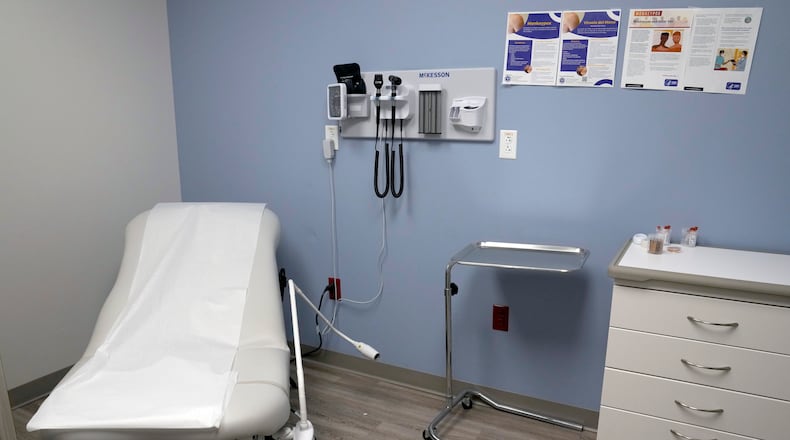“Abortion access is a fundamental right and a critical component of health care,” said Lauren Blauvelt, executive director of Planned Parenthood Advocates of Ohio.
A total of 22,000 abortions were reported in Ohio in 2023, compared to 18,488 in 2022 and 21,813 in 2021, according to ODH data.
Abortions obtained in Montgomery County increased
“This is the true health crisis in Montgomery County,” said Margie Christie, executive director of Dayton Right to Life.
More than 19% of the abortions took place in Montgomery County, according to ODH, which was the second highest after Cuyahoga County.
“If 82 children died each week from gun violence, the city and local leaders would be demanding action and change,” said Christie, referencing the 4,283 abortions reported as taking place in Montgomery County in 2023.
Almost a decade prior, there were 1,855 abortions reported in Montgomery County in 2014, according to ODH.
“Yet the lives of these children are not only ignored, they are not even mourned or acknowledged. This community is losing generations of citizens, and the silence is deafening,” Christie said.
Total figures see little change over recent years
While the number of abortions taking place in Montgomery County has more than doubled since 2014, there has not been much change in the total number of abortions taking place in Ohio. There were 21,186 abortions reported in all of Ohio in 2014.
Not including 2022 when there were 18,488 abortions reported in the state, the lowest number of abortions reported between 2023 and 2014 was in 2019 when there were 20,102 abortions reported in all of the state, ODH data says.
Despite the ups and downs of recent years, the number of abortions in Ohio has generally been decreasing each year since the 1980s. In 1983, there was a high of more than 45,000 abortions recorded, according to ODH data.
Travelers increase after voters pass amendment
The percentage of out-of-state residents seeking abortions in Ohio is increasing. Of the 22,000 abortions reported in Ohio last year, 19,229 were obtained by Ohio resident women, or about 87%, ODH says. This means about 13% of patients were from outside Ohio, which is up from about 7% in 2022 and 5% in 2021.
“Ohio is prepared to continue welcoming out-of-state patients, as we’ve done in recent months in response to extreme bans and restrictions across the Midwest and South,” Blauvelt said.
More than half of all induced abortions in 2023 involved pregnancies of less than nine weeks (60.8%), with approximately 25.9% involving pregnancies of nine to 12 weeks, ODH says.
There were 476 abortions in 2023 involving pregnancies of 19 or more completed weeks of gestation, ODH says, which is in the middle of a pregnancy’s second trimester. That represents an increase from the 342 reported in 2022.
Abortion in Ohio is legal up until the point of fetal viability, which is around 21 weeks, due to the state constitutional amendment passed by 56.6% of voters last year that protected access to abortion and other reproductive health care.
“With the Ohio Reproductive Freedom Amendment in place and our ongoing efforts to dismantle barriers to abortion, Planned Parenthood affiliates in Ohio remain a vital resource for all patients seeking essential reproductive care, regardless of their zip code, gender identity, income or insurance coverage,” Blauvelt said.
Court challenges halt Ohio laws
Clinics and advocates who support access to abortion have continued to challenge Ohio’s abortion restrictions in court, where judges in Franklin and Hamilton counties have granted temporary injunctions against some of Ohio’s abortion-related laws.
“Our goal is to have the constitutional amendment that voters passed last November fully implemented, and since we have folks at the statehouse like (governor) Mike DeWine, (attorney general) Dave Yost and (lieutenant governor) Jon Husted, that are not interested in the decision that the people made, and so that’s why we have to litigate,” said Nan Whaley, president and CEO of Planned Parenthood Southwest Ohio Region.
In August, a court in Franklin County temporarily blocked Ohio’s law requiring patients to wait 24 hours in order to obtain an abortion. For clinics that conduct abortions, they saw this law has an unnecessary hindrance with no medical benefit. For anti-abortion activists, this was mandated time to reflect on an irreversible medical decision.
Also around that time, a Hamilton County judge granted a temporary injunction on Ohio’s FDA label restriction on abortion medication, meaning doctors can prescribe the drug mifepristone off-label, a common practice among physicians for other medications.
Other findings in the Ohio Department of Health’s annual abortion report show:
- 8.8% of women who obtained abortions in 2023 were under 20 years of age, with another 28.9% between the ages of 20-24 years of age.
- 81.7% of women who obtained abortions in Ohio were never married, divorced or widowed.
- 12.1% of women who obtained abortions in Ohio were married or separated.
- Of all resident women who obtained abortions and for whom race was reported, approximately 49.8% were Black, 42.2% were white, 3.0% were Asian/Pacific Islander and 4.7% reported more than one race.
- 7.4% of women with known ethnicity who obtained abortions in Ohio were of Hispanic origin.
- The 2023 Ohio abortion rate was 8.7 per 1,000 resident women ages 15-44 years old, an increase from the 7.8 rate in 2022.
About the Author


